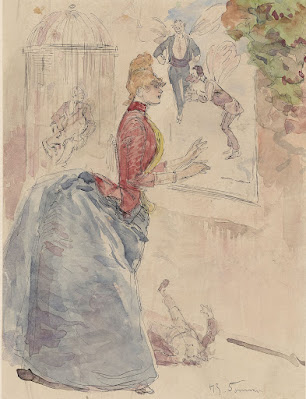-Kupferstichkabinett-Staatliche-Museen-zu-Berlin.jpg) |
| Federico Barocci Figure of Christ ca. 1590-1600 drawing (study for painting, Noli me tangere) Kupferstichkabinett, Staatliche Museen zu Berlin |
 |
| Wilhelm Berglund Violin Player 1933 watercolor on paper Prins Eugens Waldemarsudde, Stockholm |
-Morgan-Library-New-York.jpg) |
| Edgar Degas Académie 1856 drawing Morgan Library, New York |
-460-BC-marble-relief-Antikensammlung-Staatliche-Museen-zu-Berlin.jpg) |
| Ancient Greek Culture Grave Stele of a Girl (the Giustiniani Stele) 460 BC marble relief Antikensammlung, Staatliche Museen zu Berlin |
 |
| Carl Jacob Malmberg Untitled ca. 1875 albumen print Moderna Museet, Stockholm |
 |
| Henry Somm Les Vieux Papillons ca. 1880 watercolor Morgan Library, New York |
-1908-oil-on-canvas-Zornmuseet-Mora-Sweden.jpg) |
| Anders Zorn Vallkulla 1908 oil on canvas Zornmuseet, Mora, Sweden |
 |
| Moise Benkow Model Study II 1932 gelatin silver print Moderna Museet, Stockholm |
-Dresden.jpg) |
| Carl Gustav Carus Woman seated on a Terrace 1824 oil on canvas Galerie Neue Meister (Albertinum), Dresden |
-c1895-lithograph-(poster)-Kunstbibliothek-Staatliche-Museen-zu-Berlin.jpg) |
| Adolphe Crespin Amor Vincit Omnia - Robert B. Goldschmidt (chemist and inventor) ca. 1895 lithograph (poster) Kunstbibliothek, Staatliche Museen zu Berlin |
-1909-lithograph-(poster)-Kunstbibliothek-Staatliche-Museen-zu-Berlin.jpg) |
| Géza Faragó Törley (advertisement for wine) 1909 lithograph (poster) Kunstbibliothek, Staatliche Museen zu Berlin |
 |
| Joseph Heintz the Elder Sheet of Studies ca. 1590 drawing Museum of Fine Arts, Budapest |
-Mus%C3%A9e-des-Beaux-Arts-de-Lyon.jpg) |
| Jean-Auguste-Dominique Ingres Personification of The Odyssey 1850 oil on canvas (derived from The Apotheosis of Homer, 1827) Musée des Beaux-Arts de Lyon |
 |
| Georgios Margaritis Sappho praying to Aphrodite ca. 1840 oil on canvas National Gallery, Athens |
 |
| Pier Francesco Mola Bacchus and Ariadne ca. 1660 oil on canvas Herzog Anton Ulrich Museum, Braunschweig |
 |
| Hans Thoma Loneliness 1880 drawing National Museum, Warsaw |
When I was hunting on Lesbos, I saw the most beautiful sight I have ever seen, in a grove that was sacred to the Nymphs: a painting that told a story of love. The grove itself was beautiful – thickly wooded, flowery, well watered; a single spring nourished everything, flowers and trees alike. But the picture was lovelier still, combining great artistic skill with an exciting, romantic subject. Many people were attracted by its fame and came, even from abroad, to pray to the Nymphs and to look at the picture.
The picture: women giving birth, others dressing the babies, babies exposed, animals suckling them, shepherds adopting them, young people pledging love, a pirates' raid, an enemy attack – and more, much more, all of it romantic. I gazed in admiration and was seized by a yearning to depict the picture in words.
I searched out an interpreter of the picture and produced the four volumes of this book, as an offering to Love, the Nymphs, and Pan, and something for mankind to possess and enjoy. It will cure the sick, comfort the distressed, stir the memory of those who have loved, and educate those who haven't. For certainly no one has ever avoided Love, and no one will, as long as beauty exists, and eyes can see. As for me – may the god Love let me write about others' passions but keep my own self-control.
– Longus, from Daphnis and Chloe (2nd century AD), translated from Greek by Christopher Gill (1989)